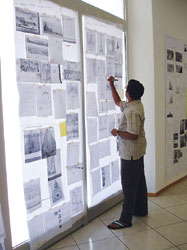 Project Manager. Auburn University student author edits construction-history-book galleys.
|
Some of the world’s greatest structures are architectural wonders, but little or no detail exists about how they were built. Soon, however, ambitious construction students from Alabama’s Auburn University will fill that gap.
With help from supportive faculty and industry experts, a lot of hard work and a whirlwind summer trip studying ancient and modern buildings, 21 students from Auburn’s McWhorter School of Building Science will publish the first definitive textbook on the construction challenges of architecture’s global icons. While the book will help teach construction history to Auburn’s future freshmen classes, its creators say peers in other schools will also find it valuable.
The research effort alone was a transforming experience for the student-authors as they launch their own construction careers. “The project has changed me as a builder because I’ve learned that anything is possible,” says participant Jeff Jantz. “It makes me want to put back a focus on constructing quality buildings that last hundreds of years instead of on how fast and cheap we can build.”
The project is the brainchild of Linda Ruth, an architect and associate professor in the school, which is within Auburn’s College of Architecture, Design & Construction. Begun in 1947, it is the second- oldest U.S. construction-education program. The book emerged from her frustration in not finding an adequate text for her construction-history class. “I realized it was really a void,” she says, noting a literary focus on architecture styles rather than on builders and their methods.
The book became the group project for the 21 upper-level building-science students who first had to compete for limited spots in Ruth’s “Deconstructing Construction” class, based on high-quality writing, research and other skills.
Students last spring were then each assigned to research landmark structures through the ages that represent unique genres and key strides in construction technology. These would make up separate book chapters and ranged from the ancient Egyptian pyramids and the Parthenon in Greece to Paris’ Eiffel Tower and the modernistic Guggenheim Museum in Bilbao, Spain.
Topics included types of construction materials, transportation approaches, impact of soil conditions, labor force and challenges. Students even drew up modern construction-related documents for the ancient landmarks. “Four thousand years ago, there were the same problems, but different solutions,” Ruth says.
 Globe Trot. Students studied landmarks in nine countries this summer.
|
High Point
The project’s high point was a two-month trip last summer by 18 students to nine countries in Europe and north Africa to study their sites’ construction up close and to give oral presentations to their co-authors. These were often followed by meetings with local experts.
In Cairo, the group was met by Zahi Hawass, a world-renowned archaeologist and secretary general of Egypt’s Supreme Council of Antiquities. He arranged special permission for the students to explore usually restricted areas of the Great Pyramids, including the workers’ village. “The visit to the site is critical,” says Ruth. “The 3D experience helps the students’ writing and gets them invested.” Also key to the project are two of Ruth’s faculty colleagues in the architecture college—Michael Hein, a professor who helped students analyze structures, and Paul Holley, an associate construction management instructor who aided in the understanding of project management. They also traveled abroad.
The book’s working title, so far, will be the same as the class name. Each chapter highlights an architectural period but will focus on one well-known structure of the time by presenting it through its construction steps. “The student is still introduced to architectural styles, but from the view of the builder, not the designer,” Ruth says.
Students say the travel experience was eye-opening not just because of language and cultural exchanges, but also in understanding construction techniques that differ from those at home and the tough conditions faced by craft workers in past eras. Participants were also asked to assess ancient landmarks using modern approaches. Grad student Michael McDonald, who is responsible for the book’s Great Pyramid chapter, estimated that building the icon today would cost more than $1.8 trillion.
“Things were done a certain way thousands of years ago that are being done now but are called new and innovative,” says Daniel Burson, a participant who is researching the Palace of Knossos on the Greek island of Crete. Adds Lauren Wybenga, who is responsible for the chapter on Rome’s Pantheon: “I learned not be intimidated or closed off to possibilities in construction.”
Ruth says some book chapters will be be ready for online class use at Auburn this semester. Although text and graphics are still being edited and several chapters have yet to be written, publishers are already expressing interest, she says. Bridging the gap between student-written chapters and a finished book is Ross Heck, a graphics expert in Auburn’s industrial design department, who is handling layout and design.
Ruth is thinking about expanding the book to include construction landmarks from Asian cultures and American contributions such as the suspension bridge. “I’m hopeful for the day that we can travel to Iraq to study the Ziggurat of Ur, but that will definitely have to wait for a future edition,” she says.
Last month, Ruth took three students to Europe to research chapters on the Stonehenge monument and the O2 dome in England (formerly called Millennium Dome), and to London’s curved 30 St. Mary Axe skyscraper designed by noted British architect Norman Foster. Sara Richter, a senior construction major, will research and present the latter project for her undergraduate thesis. “This project is really a good thing,” she says. “I mean, we didn’t even have a book to use in our class.”
 |
“It’s been wonderful for students to see the profession has a history.”. — Linda Ruth,
Associate Construction Professor |
Corey Lemming, who handled the Bilbao museum chapter, says the book ranks high among his Auburn experiences. “The best part was seeing the structures, architecture and history that I have been learning about the last four years,” he says. “When I run into a problem on a construction site, I will remember the buildings I visited this summer.”
Ruth thinks the book project has been a more-than-effective teaching tool. “It’s been wonderful for the students to start to see that their profession actually does have a history,” she says.
 Related Links:
Related Links: 
Post a comment to this article
Report Abusive Comment